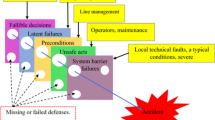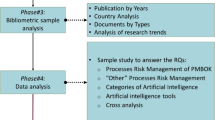Abstract
Projects are dealing with bigger stakes and facing an ever-growing complexity. In the first place, project risks have increased in number and criticality. Lists of identified project risks thus need to be broken down into more manageable clusters. Existing techniques for this are generally based on a well-known parameter such as the nature of the risk or its ownership. The limits of this approach are that project risk interactions are not properly considered. Project interdependent risks are thus often analysed and managed as if they were independent. The consequence is that there may be a lack of consideration of potential propagation through this risk network. A change may have dramatic consequences if the propagation chain is not clearly identified and/or not managed. Our objective in this paper is to propose a methodology for grouping risks so that the project risk interaction rate is maximal inside clusters and minimal outside. What we hope to achieve is a method that facilitates the coordination of complex projects which have many interrelated risks with many different risk owners. We contend that the capacity of risk owners to communicate and make coordinated decisions will be improved if they are grouped in such a way. This proposed reconfiguration of organisation is complementary to existing configurations. To do this, we first model project risk interactions through matrix representations. Then, the mathematical formulation of the problem is presented, and two heuristics are introduced. A case study in the civil engineering industry (a large infrastructure public–private partnership project) is presented, which enables us to propose global recommendations, conclusions and perspectives.






Similar content being viewed by others
References
Baccarini D (1996) The concept of project complexity—a review. Int J Project Manag 14(4):201–204
Ben-Arieh D, Sreenivasan R (1999) Information analysis in a distributed dynamic group technology method. International J Product Econ 60–61:427–432
Bouzaïene-Marle L (2005). AVISE, Anticipation du Vieillissement par Interrogation et Stimulation d’Experts. Laboratoire Genie Industriel, Ecole Centrale Paris, PhD
Chen S, Lin L (2003) Decomposition of interdependent task group for concurrent engineering. Comput Indus Eng 44(3):435–459
Clarkson J, Simons C, Eckert C (2004) Predicting change propagation in complex design. J Mech Des 126. doi:10.1115/1.1765117
Dong Y, Zhuang Y, Chen K, Tai X (2006) A hierarchical clustering algorithm based on fuzzy graph connectedness. Fuzzy Sets Syst 157:1760–1774
Durgaprasad J, Rao T (1997) Parameter interdependencies for development of KBS for risk analysis. J Comput Civil Eng 11(4):224–230
Earl C, Johnson J, Eckert CM (2001) Complexity in planning design processes. In: 13th International conference on engineering design. Glasgow, Scotland
Eckert C, Clarkson J, Zanker W (2004) Change and customisation in complex engineering domains. Res Eng Des 15:1–21. doi:10.1007/s00163-003-0031-7
Edmonds B (1999). Syntactic measures of complexity. Faculty of arts. Manchester, University of Manchester. PhD
Elhag TMS, Wang YM (2007) Risk assessment for bridge maintenance projects: neural networks versus regression techniques. J Comput Civil Eng 21:402–409
Eppinger S, Salminen V (2001) Patterns of product development interactions. International Conference on Engineering Design, Glasgow, Scotland
Eppinger S, Whitney DE, Smith R, Gebala D (1994) A model-based method for organizing tasks in product development. Res Eng Des (6):1–13
Freeman L (1977) Set of measures of centrality based on betweenness. Sociometry 40:35–41
Giffin M, De Weck O, Bounova G, Keller R, Eckert C, Clarkson J (2009) Change propagation analysis in complex technical systems. J Mech Des 131. doi:10.1115/1.3149847 (081001-1)
Girvan M, Newman M (2002) Community structure in social and biological networks. Proc Nat Acad Sci (PNAS) 99(12):7821–7826. doi:10.1073/pnas.122653799
Gusfield D (1997) Algorithms on strings, trees and sequences. Cambridge University Press, Cambridge
Hartigan JA (1975) Clustering algorithms. Wiley, London
Hennig C, Hausdorf B (2006) A robust distance coefficient between distribution areas incorporating geographic distances. Syst Biol 55(1):170–175
Iyer KC, Mohammed S (2010) Hierarchical structuring of PPP risks using interpretative structural modeling. J Construct Eng Manag 136(2):151–159
Kannan R, Vempala S, Vetta A (2001) On clusterings: good, bad and spectral working paper
Karp RM (1976) Probabilistic analysis of partitioning algorithms for the travelling salesman problem in the plane. Math Oper Res 2(3):209–224
Kim S (2003) Graph theoretic sequence clustering algorithms and their applications to genome comparison. In: Wu CH, Wang P, Wang JTL (eds) Computational biology and genome informatics, vol 4. World Scientific, Singapore
Kloss-Grote B, Moss M (2008) How to measure the effectiveness of risk management in engineering design projects ? Presentation of RMPASS: a new method for assessing risk management performance and the impact of knowledge management–including a few results. Res Eng Design 19:71–100. doi:10.1007/s00163-008-0049-y
Lakroum S, Devlaminck V, Terrier P, Biela-Enberg P, Postaire JG (2005) Clustering of the poincare vectors image processing, 2005. ICIP 2005. IEEE Int Conf 2:11–14
Laurikkala H, Puustinen E, Pajarre E, Tanskanen K (2001) Reducing complexity of modelling in large delivery projects. International Conference on Engineering Design, Glasgow, Scotland
Le Moigne J (1990) La théorie du système général. Théorie de la modélisation, Presses Universitaires de France
Lough K, Van Wie M, Stone R, Tumer I (2009) Promoting risk communication in early design through linguistics analyses. Res Eng Des 20:29–40
Mahalanobis PC (1936) On the generalised distance in statistics. Proc Nat Inst Sci India 2(1):49–55
Marle F (2002) Methods for helping decision-making in projects. PMI Europe Conference, Cannes, France, June 2002
Phelan S (1995). From chaos to complexity in strategic planning. In: 55th meeting of Academy of Management, Vancouver
PMI SC (2008) A guide to the project management body of knowledge (PMBOK) (2008 ed). Newton Square, PA, USA (Project Management Institute)
Rodgers JL, Nicewander WA (1988) Thirteen ways to look at the correlation coefficient. Am Stat 42:59–66
Saaty T (1980) The analytic hierarchy process: planning, priority setting. Resource Allocation, McGraw-Hill
Schaeffer SE (2007) Graph clustering. Comput Sci Rev I:27–64
Shi J, Malik J (2000) Normalized cuts and image segmentation. IEEE Trans Pattern Anal Mach Intell 22(8):888–905
Simon H (1981) The sciences of the artificial. The MIT Press, Cambridge
Sosa M (2008) A structured approach to predicting and managing technical interactions in software development. Res Eng Des
Steward D (1981) The Design structure matrix: a method for managing the design of complex systems. IEEE Trans Eng Manag 28(3):71–74
Suh N (1999) A theory of complexity, periodicity and the design axioms. Res Eng Design 11:116–133
Vidal L, Marle F (2007) Modeling project complexity. International Conference on Engineering Design, Paris
Vidal L, Marle F (2008) Understanding project complexity: implications on project management. Kyber Int J Syst Cybern Manag Sci
Vidal L, Marle F, Bocquet JC (2009) Interactions-based clustering to assist project risk management. International Conference on Engineering Design ICED’09, Stanford
Yin Y, Yasuda K (2006) Similarity coefficient methods applied to the cell formation problem: A taxonomy and review. Int J Product Econ 101:329–352
Zika-Viktorsson A, Ritzen S (2005) Project competence in product development. Res Eng Design 15:193–200. doi:10.1007/s00163-004-0051-y
Zotteri G, Kalchschmidt M, Caniato F (2005) The impact of aggregation level on forecasting performance. Int J Product Econ 93–94:479–491
Author information
Authors and Affiliations
Corresponding author
Rights and permissions
About this article
Cite this article
Marle, F., Vidal, LA. Project risk management processes: improving coordination using a clustering approach. Res Eng Design 22, 189–206 (2011). https://doi.org/10.1007/s00163-011-0106-9
Received:
Accepted:
Published:
Issue Date:
DOI: https://doi.org/10.1007/s00163-011-0106-9




